| IN THIS ISSUE |
|
The Master Writes
• In Theory...
Assume the Position
|
Q&A: We need your chess questions and games in PGN for
our Ask the Masters sections! Send them to blackbelt@chessninja.com.
Download all the chess material in this issue in PGN
(text) or CBV (ChessBase). Play
over it online here.
Download this issue in Adobe
Acrobat format (.pdf) with all graphics included. Perfect for offline
viewing and easy printing. You'll need to install the free Acrobat
Reader first.
FEEDBACK: Please tell us what you like and don't like, if
things are too easy or too hard, and suggest new sections. Post
your comments in the Black Belt content poll
or e-mail us at blackbelt@chessninja.com.
|
|
It may be winter (in the northern hemisphere at least), but
the chess world is hot in January. The US Championship started
today in Seattle, Corus Wijk aan Zee has most of the top 10, and
Kasparov will play against Junior in New York on the 26th.
We'll have games and more from all these events in upcoming issues.
Meanwhile you can vote on who you think will win and why in the
message
boards.
We have two of the Wijk aan Zee favorites with us today. World
#3 Viswanathan Anand annotates a game from his 2002 match against
FIDE champ Ponomariov just for Black Belt subscribers! Then we take
a look at five Judit Polgar games in a new section.
|
| NINJA NEWS |
|
 Which
players and writers would you like to see contribute to Black Belt?
If you have a favorite, let us know at the Black
Belt message board. Upcoming contributors include Vishy Anand,
US Champion Larry Christiansen, former US champ Joel Benjamin, and
IM Sofia Polgar! Who else? You decide. Which
players and writers would you like to see contribute to Black Belt?
If you have a favorite, let us know at the Black
Belt message board. Upcoming contributors include Vishy Anand,
US Champion Larry Christiansen, former US champ Joel Benjamin, and
IM Sofia Polgar! Who else? You decide.
|
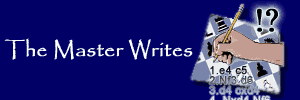 |
|
Black
Belt welcomes a man who truly needs no introduction. 2000
FIDE World Champion and current #3 player in the world, Viswanathan
Anand of India!
|
|
|
 In
2002 the organizers of the Mainz Chess Classic invited reigning
FIDE world champion Ruslan Ponomariov to play an eight-game rapid
chess match against 2000 FIDE champ Vishy Anand. The year before,
Anand had won the Mainz event against Vladimir Kramnik and was back
to defend his title. The young Ponomariov took the early lead by
winning game three. Anand struck back immediately with this devastating
win. He would later take the match by a point by winning the final
game. More
on the match at ChessBase. In
2002 the organizers of the Mainz Chess Classic invited reigning
FIDE world champion Ruslan Ponomariov to play an eight-game rapid
chess match against 2000 FIDE champ Vishy Anand. The year before,
Anand had won the Mainz event against Vladimir Kramnik and was back
to defend his title. The young Ponomariov took the early lead by
winning game three. Anand struck back immediately with this devastating
win. He would later take the match by a point by winning the final
game. More
on the match at ChessBase.
In this game, subtle maneuvers on the kingside create a central
pawn weakness in Black's position. The exchange sacrifice that
follows gives White a dominating position. Black gives back the
material but can't avoid a sparkling finish. We strongly recommend
that you play through all of the rich variations presented, they
will reward your hard work.
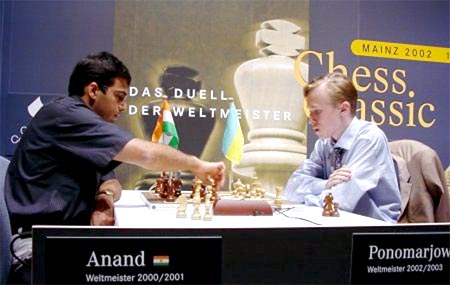
Anand,V (2755) - Ponomariov,R (2743)
[B90] Duel of the World Champions
Mainz, Germany (Round 4), 17.08.2002
Annotations by Viswanathan Anand
Ruslan had just taken the lead with a fine win in our 3rd game.
1.e4 c5 2.Nf3 d6 3.d4 cxd4 4.Nxd4 Nf6 5.Nc3 a6 Following
our 2nd game. Since he dominated the play on the first day, I felt
that it wasn't enough to try and come up with some little refinement
on our 2nd game. I wanted to go for really sharp lines to try and
fight for the initiative in the match.
|
|
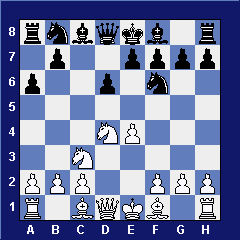 6.f3
'!' This skips the Ng4 line and takes the play into sharper
lines. 6...e6 7.Be3 b5 8.g4 Nfd7 9.Qd2 Bb7 6.f3
'!' This skips the Ng4 line and takes the play into sharper
lines. 6...e6 7.Be3 b5 8.g4 Nfd7 9.Qd2 Bb7
[9...Nb6 10.0-0-0 N8d7 Ponomariov has some experience with this
position, but earlier this year Grischuk had a famous win against
Dvoiris from the Aeroflot open. (10...Bb7 Transposing back
to the game.) 11.Ndxb5!]
10.0-0-0 Nb6 11.Nb3 N8d7 12.Na5 Qc7 Of course, Black isn't
going to play Bc8. 13.Kb1 Maybe technically a novelty, but
simply one of the "useful" moves one makes in the Sicilian - the
kingside equivalent is Kh1. 13...Be7
[13...b4 14.Ne2 d5 The thematic reaction in the centre. 15.Ng3
Be7 16.Nxb7 Qxb7 17.f4 0-0 (17...dxe4 18.Nxe4) 18.Bd3]
|
|
 14.h4
Here I already saw the possibility of playing Bg5, but decided
to wait a bit. [14.Bg5 Bxg5 15.Qxg5 0-0 16.Nxb7 Qxb7 17.Rxd6 Qc7
with compensation ] 14...0-0?! 14.h4
Here I already saw the possibility of playing Bg5, but decided
to wait a bit. [14.Bg5 Bxg5 15.Qxg5 0-0 16.Nxb7 Qxb7 17.Rxd6 Qc7
with compensation ] 14...0-0?!
[14...Ne5 15.Qd4! Nbd7 16.Nxb7 Qxb7 17.f4 b4 a) 17...Nf3
18.Qd3± (a) 18.Qxg7 Bf6 19.Qh6 Bxc3 20.bxc3 Qxe4 21.Bc1)
; b) 17...Nxg4 18.Qxg7 Nxe3 19.Qxh8+ Nf8 20.Re1+-; 18.Na4
Nxg4 19.Qxg7 Nxe3 20.Qxh8+ Nf8 21.Re1 Qxe4 22.Bd3 Qxf4 23.Qg8±;
14...b4! 15.Ne2 d5 16.Nd4 (16.Nxb7 Qxb7 (16...Nc4 17.Qc1 dxe4
18.Ng3 Nxe3 19.Qxe3 Qxb7 20.Nxe4 0-0 21.g5 slight advantage white)
17.Ng3 0-0 unclear) 16...dxe4 17.Nxb7 Qxb7 18.fxe4 0-0=]
15.Bg5 The point of the previous move. White can recapture
with the h-pawn and attack on the h-file. 15...f6 This weakens
the e6 square and gives White an easy target. The only thing that
concerned me was that White has lost some time.
[15...Nf6 16.h5! White just continues his attack. (16.Bxf6 Bxf6
(16...gxf6 17.g5±) 17.Qxd6 Rac8 18.Qxc7 Rxc7 19.Ne2 Black
has enough compensation with his two bishops. (19.Nxb7 Rxb7 with
compensation) 19...Na4) ] 16.Be3 Ne5 17.Qf2 Nbc4 18.Nxb7
Qxb7 19.Bd4 [19.Ne2 f5! 20.gxf5 exf5 21.Bh3 fxe4 22.Be6+ Kh8
23.Bd5 Qc8 24.Bxa8 Qxa8 slight advantage black] 19...Rac8
|
|
 20.Ne2 20.Ne2
[20.Qg3 This stops f5, but White has to take some sacrifices into
account. 20...b4 21.Ne2 Na3+! (21...Qc6 22.Ka1) 22.bxa3 bxa3+
At the board, I felt that this was very dangerous and decided to
stick to 20.Ne2. Later analysis confirmed this: 23.Kc1 Counter-intuitively,
White ambles off to the other side. The obvious tries don't break
through.
(23.Ka1 Rxc2 24.Rb1 Rb2!! 25.Bg2 (25.Bxb2 Rb8-+; 25.Rxb2 axb2+
26.Kb1 Nc4-+) 25...Rb8 26.Qe1 Nc4 and Black is better.) However,
an unusual knight retreat keeps Black going. 23...Nc6! a) 23...Rxc2+
24.Kxc2 Rc8+ 25.Kd2; b) 23...Rc7 24.Ba1 Rfc8 25.Nd4; c)
23...Qb4 24.Ba1 Rxc2+ (c) 24...Rb8 25.Nc3 Rfc8 26.f4)
25.Kxc2 Rc8+ 26.Nc3; 24.Ba1 (24.Kd2 d5! 25.Ke1 Nxd4 26.Nxd4
e5) 24...Nb4 25.Nc3 d5!
A sample variation follows. 26.exd5 Rxc3 27.Bxc3 Nxa2+ 28.Kd2 Nxc3
29.Kxc3 Bb4+ 30.Kd3 Qxd5+ 31.Ke2 Qxd1+! 32.Kxd1 a2]
20...Nc6 [20...f5 21.gxf5 exf5 22.Qg3! This looks fine for
White. (22.exf5 Qxf3 23.Qxf3 (23.Bh3 Nd2+! 24.Ka1 (24.Rxd2 Qxh1+)
24...Rxc2-+) 23...Nxf3 24.Bg2 Rxf5 (24...Nxd4 25.Nxd4 Ne3
26.Rde1 Bf6 27.Rxe3 Bxd4 28.Ra3) 25.Bh3 Nxh4 26.Ng3 Rcf8 27.Nxf5
Nxf5) …22...fxe4 23.f4] 21.Be3
[21.Bh3 b4 22.g5 This also looked strong, but I wanted to get my
knight to f4 and for that I have to move my bishop.] 21...Nxe3
[21...f5 22.exf5 exf5 23.g5 N6e5 24.Nd4±; 21...Nb4 22.Nd4 (22.c3
Nc6 23.Nf4±) 22...e5 23.Nf5 (23.Bxc4+ Rxc4) 23...Nxb2
24.Kxb2 Rxc2+ 25.Qxc2 Nxc2 26.Kxc2±] 22.Qxe3 Qa7? Probably
he just missed White's next. However, his position was already difficult.
[22...Ne5 23.Nd4 Qd7 24.Bh3 with the initiative.]
|
|
 23.Qb3!
d5 [23...Qd7 24.Nf4 Kf7 No further commentary is needed.] 24.exd5
Na5 25.Qd3 Nc4 23.Qb3!
d5 [23...Qd7 24.Nf4 Kf7 No further commentary is needed.] 24.exd5
Na5 25.Qd3 Nc4
Here I found the simplest way. 26.Nf4 Ne3 27.Nxe6 Nxd1 28.Qxd1!
I couldn't bring myself to calculate Nxf8 since this move wins
trivially. White just plays Bd3 and follows up on the kingside -
Black is helpless.
[28.Nxf8 Nc3+! (28...Nf2 29.Qxh7+ Kxf8 30.Bd3! Nxh1 31.Qh8+
Kf7 32.Bg6+ Kxg6 33.Qh5#) 29.bxc3 Bxf8 30.Qf5+-] 28...Rfe8
29.Bd3 There is no way for Black to counter White's attack.
White just pushes his kingside pawns. 29...Qf2 30.f4 Bd6 31.g5
'!' 31...Rxe6 32.dxe6 Qxf4 33.Rf1 Qe5 34.Re1 Qc5 [34...Qf4
35.e7+-] 35.gxf6 gxf6 36.Qg4+ Kh8 37.Rg1 Qc7
|
|
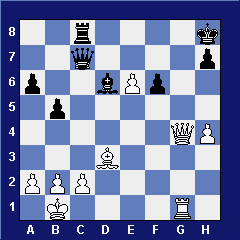 38.e7
1-0 38.e7
1-0
View
game online
The Tactics Ninjas thank GM Anand for a great example
of an interference theme on the final move. Good luck in Wijk aan
Zee, Vishy! (He is currently leading the
poll to pick the winner by a large margin over Kramnik, Karpov,
and Topalov.)
|
 |
|
Maroczy and Polgar Go to Benidorm
 Instead
of looking at specific variations this week we are going to see
a pawn formation that has been seen often at the top level recently.
The Maroczy Bind bears the name of the Hungarian Geza Maroczy for
nebulous reasons, as with most opening nomenclature. It involves
pawns on c4 and e4 against a black pawn on d6. (This can happen
reversed, with black pawns on c5 and e4 versus a white pawn on d3.) Instead
of looking at specific variations this week we are going to see
a pawn formation that has been seen often at the top level recently.
The Maroczy Bind bears the name of the Hungarian Geza Maroczy for
nebulous reasons, as with most opening nomenclature. It involves
pawns on c4 and e4 against a black pawn on d6. (This can happen
reversed, with black pawns on c5 and e4 versus a white pawn on d3.)
As the word "bind" implies, the white pawns create
powerful positional pressure against the black position. Black
must find a way to strike back on the flanks. A skill for maneuvering
with limited space is essential for playing these positions with
black, and not many GMs enjoy such things.
50 years ago it was considered almost losing to allow the Bind,
but the dynamic post-WWII players of the USSR found many new strategies.
Later, players like Ulf Andersson and Mikhail Suba would happily
play the black side to lure white into a hasty expansion that would
backfire.
In the past decade, however, few top GMs have gone for these
positions. Dynamic defenses like the Grunfeld and sharp Najdorf
Sicilians have dominated. Lately there has been a resurgence of
the Bind as players with black are trying ..e6 and ..g6 Sicilian
lines. Even Garry Kasparov allowed the Bind in a game from the 2002
Bled Olympiad. He easily broke free and gained a quick draw against
Akopian, who had beaten him just weeks earlier in a different Sicilian
line.
|
|
 Even
ultra-dynamic players like Judit Polgar and Alexei Shirov have been
playing the black side, so this is definitely not the Bind that
Maroczy knew 100 years ago! Even
ultra-dynamic players like Judit Polgar and Alexei Shirov have been
playing the black side, so this is definitely not the Bind that
Maroczy knew 100 years ago!
Polgar used the Bind as white three times in the Hotel Bali tournament
in Benidorm, Spain, and faced it twice as black. Of these five games
she scored 4.5 points (!), so let's see what she can teach us about
plans for both sides.
San Segundo Carrillo,P (2523) - Polgar,J (2685) [E92]
Superstars Hotel Bali. Benidorm ESP (2), 29.11.2002
1.d4 Nf6 2.c4 g6 3.Nc3 Bg7 4.e4 d6 5.Nf3 0-0 6.Be2 e5 7.Be3
Ng4 8.Bg5 f6 9.Bh4 g5 10.Bg3 Nh6 11.h3 Nc6 12.dxe5 fxe5 13.Qd2
|
|
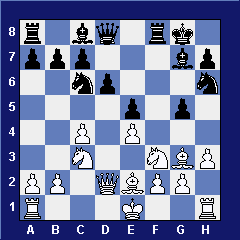 13...Nf7!
14.Nh2 Typical activity when there are few pawn breaks. You
must find the best squares for your minor pieces and try to trade
off your bad minors for your opponent's good ones if possible. 14...Nd4
15.Bg4 Not wanting to leave Black with the bishop pair. 15...Nh8
16.Nf1 Ng6 17.Ne3 Nf4 The knight dance is over. Black has masterfully
infiltrated into the weak dark squares. It was hard to imagine such
a position just five moves ago. 13...Nf7!
14.Nh2 Typical activity when there are few pawn breaks. You
must find the best squares for your minor pieces and try to trade
off your bad minors for your opponent's good ones if possible. 14...Nd4
15.Bg4 Not wanting to leave Black with the bishop pair. 15...Nh8
16.Nf1 Ng6 17.Ne3 Nf4 The knight dance is over. Black has masterfully
infiltrated into the weak dark squares. It was hard to imagine such
a position just five moves ago.
18.f3 c6 On to stage two: breaking down the Bind on the
flank. 19.Bxc8 Rxc8 20.h4 White has some counterchances on
the kingside.
20...b5 21.cxb5 cxb5 22.Bxf4 exf4 Of course Polgar wants
to open up that magnificent Dragon bishop. White's king has no safe
place to hide. 23.Ned5 a5 24.Rc1 g4 25.fxg4 f3! Total devastation.
The d4 knight is a monster while the d5 knight has no targets and
also blocks in his stable-mate on c3.
White's position is in ruins on both flanks despite still maintaining
a nice central presence. 26.Kd1? b4 27.Na4 Rxc1+ 28.Kxc1 Ne2+
29.Kb1 fxg2 0-1
|
|
Polgar,J (2685) - Shirov,A (2699) [E67]
Superstars Hotel Bali. Benidorm ESP (3), 29.11.2002
1.c4 e5 2.g3 g6 3.Bg2 Bg7 4.Nc3 Nf6 5.Nf3 d6 6.0-0 0-0 7.d4
Nbd7 8.Qc2 Re8 9.Rd1 exd4 10.Nxd4 a5 11.e4 Nc5
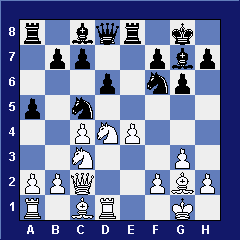 Here
we are again. Black has the powerful c5 post for his knight, protected
by the a5 pawn. He is also putting a lot of pressure on the e4 pawn.
The next 30 moves are typical of the intricate dance steps necessary
to play the Bind from either side. Both Shirov and Polgar are looking
to force the other to misplace a piece or create a weakness, all
while waiting for a chance to break out with a quick pawn thrust. Here
we are again. Black has the powerful c5 post for his knight, protected
by the a5 pawn. He is also putting a lot of pressure on the e4 pawn.
The next 30 moves are typical of the intricate dance steps necessary
to play the Bind from either side. Both Shirov and Polgar are looking
to force the other to misplace a piece or create a weakness, all
while waiting for a chance to break out with a quick pawn thrust.
12.f3 c6 13.Be3 Qe7 14.Bf2 Nfd7 15.b3 Ne5 16.h3 Ned7 17.Rd2
Bh6 18.Re2 f6 19.f4 Nf8 20.Rd1 Bd7 21.Ree1 Rad8 22.a3 Bc8 23.b4
axb4 24.axb4 Nce6 25.Nde2
After finally ejecting the knight from c5 Polgar has no intention
of letting Black alleviate his cramped position with exchanges.
Shirov has shored up the center so Polgar plays for a breakthrough
on the queenside. 25...Qc7 26.Qb3 Kh8 27.Rc1 Qf7 28.Na4 Nc7 29.Nb6
Qg8
No, this is not a typographical error! Back-rank maneuvers are
critical for anyone who wishes to play these positions with black.
Shirov feels that his third-rank line of defense is secure. 30.Nxc8
Rxc8 31.Qc2 Nd7 32.Red1 Bf8
Amazing how the black pieces move like some sort of puzzle. Just
in time, the knight gives way to the bishop to protect d6. 33.Bd4
Ra8 34.h4 Qf7 35.Bh3 Ne6 36.Bb2 Nb6 37.Nd4 Nc7 38.Nf3 Having
transformed her space advantage into the advantage of the two bishops,
Polgar looks to open the position with e5 for a direct attack. 38...Kg8
39.e5 dxe5 40.fxe5 Ra2! Counterplay at last! Shirov's patience
was remarkable. Maybe even after 40 moves White's break was too
early!
41.Qb3 Rxb2 42.Qxb2 That bishop was just too powerful. Shirov
breaks the white attack and has good compensation with the opposite
colored bishops and suddenly active pieces. Polgar decides to hang
on to the material with a combination that lands her in trouble.
42...Nxc4 43.e6? [ 43.Rxc4 Qxc4 44.exf6 Re3]
43...Nxb2 44.exf7+ Kxf7 45.Rd7+ Re7 46.Rc2 Rxd7 47.Bxd7 Nd3
Whoops! The b-pawn goes and now Black has good winning chances.
48.Bc8 Nxb4 49.Rb2? Allowing the black pawns to get rolling.
This mistake should have been fatal. [ 49.Rd2]
49...b5 50.Kg2 c5 51.Rd2 Nbd5 52.Bb7 Ke6 53.Re2+ Kd7 54.Nd2
c4 55.Ne4 Be7 [ 55...c3] 56.Rd2 Ke6 57.Re2 Kf7 58.Rd2 Ke6
[ 58...c3 Winning immediately. 59.Nxc3 ( 59.Bxd5+ Nxd5
60.Rxd5 c2; 59.Rc2 Ne3+) 59...Nxc3] 59.Re2 Kf7 60.Rd2 Nb6
61.Nd6+ Ke6 62.Nxb5! Polgar escapes with this shot. 62...Nxb5
63.Rb2 Bc5 1/2-1/2
|
|
Polgar,J (2685) - Granero Roca,A (2342) [B36]
Superstars Hotel Bali. Benidorm ESP (7), 30.11.2002
1.e4 c5 2.Nf3 Nc6 3.d4 cxd4 4.Nxd4 g6 5.c4 Nf6 6.Nc3 d6 7.Bg5
Bg7 8.Nc2 0-0 9.Be2 Qa5 10.Bd2 a6 11.0-0 Bd7 12.Rc1 Rac8 13.f4 Rfe8
14.a3
Now we see Polgar on the white side of the Bind. She immediately
begins to advance on all fronts with f4 and now prepares b4. 14...Qb6+
15.Kh1 Na5?
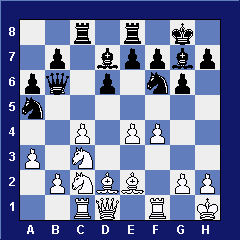 Positionally
well-motivated, tactically flawed. Black attacks the c4 pawn and
the weakened b3 square. The problem is that now e5 has been left
unguarded and Polgar doesn't miss a chance to break in the center.
Seeking activity too early is usually a crime for either side in
these positions. [15...Qxb2?? 16.Rb1] Positionally
well-motivated, tactically flawed. Black attacks the c4 pawn and
the weakened b3 square. The problem is that now e5 has been left
unguarded and Polgar doesn't miss a chance to break in the center.
Seeking activity too early is usually a crime for either side in
these positions. [15...Qxb2?? 16.Rb1]
16.e5! Nh5 Capturing first would just leave the d7 bishop
vulnerable. 17.Nd5 Qd8 18.Nce3 e6 19.Bxa5 Qxa5 20.Nc3 Qb6? 21.c5!
Wonderful stuff from the youngest Polgar. d6 is not a square
for a queen or pawn, it's a square for a knight! 21...Qxc5 22.Nc4
Bc6 23.b4 Qa7 24.Bxh5?! Right idea in the wrong order. Both
players miss a chance for Black to grovel for a while with a piece
sac on the next move. 24...gxh5
[ 24...dxe5!? This was probably the best chance to play on for
a bit longer. 25.Nd6 Rcd8 26.Bf3] 25.Nxd6 Rcd8 26.Qxh5 Re7 27.Qg5
Red7 28.f5 Kh8 29.fxe6 fxe6 30.Nf7+ 1-0
|
|
Polgar,J (2685) - Paunovic,D (2532) [B42]
Superstars Hotel Bali. Benidorm ESP (8), 30.11.2002
1.e4 c5 2.Nf3 e6 3.d4 cxd4 4.Nxd4 a6 5.Bd3 Nf6 6.0-0 d6 7.c4
b6 8.Nc3 Bb7 9.f4 g6 10.Be3 Bg7 11.Qf3 0-0 12.Rad1 Nbd7 13.Bf2 Qc7
14.Rfe1 Rfe8 15.Nb3 Nc5 16.Nxc5
 17...bxc5
A tough decision. Taking with the d-pawn would have left a dry,
symmetrical structure not to Paunovic's liking and e5 would always
be a possibility for white. Still, it made sense to get rid of the
weak d-pawn. [ 16...dxc5] 17.Bc2 I can't recall seeing
the following maneuver before. It is an original method of the maxim
"trade your bad pieces for your opponent's good ones." 17...bxc5
A tough decision. Taking with the d-pawn would have left a dry,
symmetrical structure not to Paunovic's liking and e5 would always
be a possibility for white. Still, it made sense to get rid of the
weak d-pawn. [ 16...dxc5] 17.Bc2 I can't recall seeing
the following maneuver before. It is an original method of the maxim
"trade your bad pieces for your opponent's good ones."
17...Bc6 18.Ba4 Rab8 19.b3 Ng4 20.Bxc6 Qxc6 21.e5 This should
look familiar to you by now. This push weakens the c-pawn and blocks
in the black bishop. Both sides must constantly be aware of chances
to push pawns.
21...Qxf3 22.gxf3 Nxf2 23.Kxf2 Red8 24.Ne4 dxe5 25.Nxc5 exf4
26.Nxa6 Ra8 27.Rxd8+ Rxd8 28.b4 Rd3 29.Re4 Ra3 30.b5 Rxa2+ 31.Ke1
Bc3+ 32.Kd1 Rb2 33.Re2 Rb3 34.Kc2 Ra3 35.c5 Ba5 36.Re4 Rc3+ 37.Kb2
Rxf3 38.b6 Rf2+ 39.Ka3 Rf1 40.b7 Rb1 41.Rb4! A nice final touch!
41...Rxb4 42.Nxb4 Bc7 43.Na6 Be5 44.c6 1-0
|
|
Ponomariov,R (2743) - Polgar,J (2685) [A30]
Superstars Hotel Bali Playoff. Benidorm ESP (2), 01.12.2002
1.Nf3 Nf6 2.c4 e6 3.Nc3 c5 4.g3 b6 5.Bg2 Bb7 6.0-0 Be7 7.Re1
d6 8.e4 Nbd7 9.d4 cxd4 10.Nxd4 Rb8 Watching out for e5 tricks.
11.b3 a6 12.Bb2 0-0 13.h3 Qc7 14.Qd2 Nc5 15.Rad1 Rfe8 16.f4 Ba8
17.Qf2 Ncd7
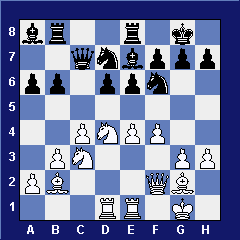 This
is the third tempo that Black gives away. Even in the Maroczy Bind
time is important. White decides that he can embark on a direct
attack. Black is not threatening any of the normal breaks with ..b5,
..d5, or ..e5. 18.g4 h6?! This allows Ponomariov to open
lines on the kingside. Usually it's better to avoid such pawns moves
for as long as possible. [ 18...Nf8 19.g5 N6d7] This
is the third tempo that Black gives away. Even in the Maroczy Bind
time is important. White decides that he can embark on a direct
attack. Black is not threatening any of the normal breaks with ..b5,
..d5, or ..e5. 18.g4 h6?! This allows Ponomariov to open
lines on the kingside. Usually it's better to avoid such pawns moves
for as long as possible. [ 18...Nf8 19.g5 N6d7]
19.g5!? Ponomariov clearly wanted to end the tiebreak in
this second game. He plays to win (or lose). This is double edged
because Black will now have e5 for her pieces. 19...hxg5 20.fxg5
Nh5 21.g6 Things are falling apart on the black kingside. Polgar
just manages to hold things together. The simpler 21.Rf1 was also
very dangerous. [ 21.Rf1 Rf8 22.Qh4 g6]
21...Bf6 22.gxf7+ Kxf7 23.Bf3 Nf4 24.Bg4 g5 It's all tactics
now and Polgar certainly wasn't unhappy about that! 25.Nde2 Qc5
26.Nxf4 gxf4 27.Qxc5 bxc5 28.Rxd6 White's plan has paid off,
right? The typical weakness has fallen and the rest of Black's pawns
are a mess. The only thing White has to do is survive the attack
on his king...
28...Bd4+ 29.Kf1 Ne5 30.Rxa6 There goes the second pawn.
Black's pieces now become hyperactive against the open white king.
30...Nxg4 31.hxg4 Rh8 32.Ra7+ Kg6 33.Kg2 f3+! Setting up
a spectacular finish. Right about now Ponomariov was probably wishing
he had done something with his other pieces instead of going pawn
hunting. 34.Kg3 Be5+ 35.Kxf3 Rh3+ 36.Ke2 Rh2+ 37.Ke3 Rxb2 38.Na4
[ 38.Ne2 would have held on a little longer.] 38...Rxa2
39.Rh1 Bd4+ [ 39...Rxb3+ 40.Nc3 Rxc3#] 40.Kf3 Rxb3+ 41.Kf4
e5# 0-1
|
|
View
games online
|
 |
|
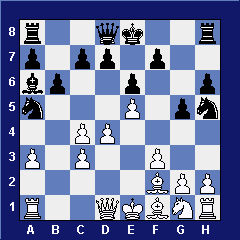 Here
is some homework for you. As always in this section, we want
you to break down the position for both sides and not worry about
the next move yet. Find the strengths and weaknesses, plans, and
possibilities for both piece play and pawn structure. Write them
down! Next week you can compare your notes to those of our Master
analysts. Here
is some homework for you. As always in this section, we want
you to break down the position for both sides and not worry about
the next move yet. Find the strengths and weaknesses, plans, and
possibilities for both piece play and pawn structure. Write them
down! Next week you can compare your notes to those of our Master
analysts.
We have a very rich position this week, with chances for both sides
on both sides of the board.
View
position online
|
|